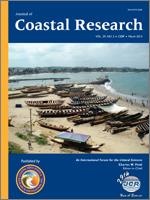Poulos, S.E.; Plomaritis, T.A.; Ghionis, G.; Collins, M.B., and Angelopoulos, C., 2013. The role of coastal morphology in influencing sea level variations induced by meteorological forcing in microtidal waters: examples from the Island of Crete (Aegean Sea, Greece).
Sea surface variations due to strong (northerly) onshore winds are compared over three different geomorphological settings of the essentially tideless (tidal range < 10 cm) northern coast of Crete (southern Aegean Sea): (i) an open beach zone; (ii) a beach zone with the same offshore characteristics as the previous zone, but protected by a shore-parallel reef; and (iii) a pocket beach located in the cove of a semienclosed gulf. Even though the three beach zones are exposed to similar meteorological forcing (strong northerly winds with speeds > 10 m s−1), they developed different water level variations depending on the local morphological conditions. The beach zone situated in the semienclosed gulf experienced a 3.3 times larger offshore sea surface rise (10 cm) than the unprotected open beach. The presence of the reef, on the third beach, caused a 2.7 times higher increase of the nearshore sea surface elevation (i.e., up to 24.5 cm) than the nearshore sea surface rise (9 cm) measured at the nearby unprotected open coast that experiences similar offshore hydrodynamic conditions. The sea surface variations in the offshore zone are induced primarily by wind forcing and, secondarily, by barometric pressure fluctuations: their corresponding ratios vary from 3.2 ∶ 1 in the unprotected open beach, to 2.2 ∶ 1 in the pocket beach located in the semienclosed gulf. Sea surface rise within the nearshore zone is controlled mainly by the wave set-up, due to breaking waves; this, at the open coast, is about 1.3 times larger than the wind set-up. Finally, the presence of the reef amplifies sea surface rise along the shoreline, which can easily exceed 0.4 m (15 times the offshore sea surface rise).





